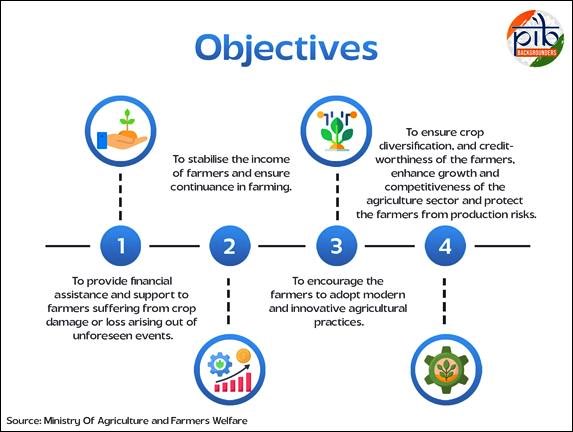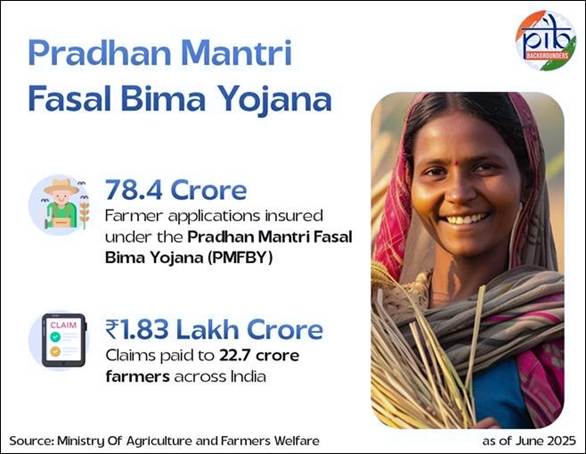Content
- Empowering Annadatas: Pradhan Mantri Fasal Bima Yojana
- Comprehensive reforms taken up to instill credit discipline in PSBs
Empowering Annadatas: Pradhan Mantri Fasal Bima Yojana
Background & Context
- Launched: 18 February 2016, replacing earlier schemes like NAIS & MNAIS.
- Objective: Provide affordable, comprehensive crop insurance to farmers for protection against non-preventable natural risks.
- Coverage: Pre-sowing to post-harvest stages, including damage during storage (if due to notified calamities).
- Principle: One Nation – One Crop – One Premium.
- Type: Area-based crop insurance scheme.
Relevance : GS 2(Governance , Schemes) ,GS 3(Agriculture)

Key Performance Statistics (2016–2025)
- Total applications insured: 78.41 crore.
- Claims paid: ₹1.83 lakh crore to 22.667 crore farmers.
- Enrolment growth:
- 3.17 crore farmers (2022–23) → 4.19 crore (2024–25) → 32% increase (highest since inception).
- Non-loanee farmer participation:
- 20 lakh (2014–15) → 522 lakh (2024–25).
- Farmer applications coverage:
- 371 lakh (2014–15) → 1510 lakh (2024–25).
- Largest crop insurance scheme in the world (in terms of farmer applications)
Financial Structure
- Premiums paid by farmers:
- Kharif food/oilseed crops – 2% of sum insured.
- Rabi food/oilseed crops – 1.5%.
- Annual commercial/horticultural crops – 5%.
- Government’s share:
- Remaining 95–98.5% borne by Centre & State.
- Sharing ratio:
- Normal States – 50:50.
- NE States (Kharif 2020 onwards) & Himalayan States (Kharif 2023 onwards) – 90:10.

Risk Coverage under PMFBY
- Yield Losses: Drought, floods, pests, diseases, cyclones, hailstorms, landslides, etc.
- Prevented Sowing: Up to 25% of sum insured if sowing fails due to adverse weather.
- Post-harvest Losses: Up to 14 days from harvest for “cut & spread” crops damaged by cyclones/cyclonic rains.
- Localized Calamities: Hailstorms, landslides, inundation impacting individual farms.
Implementation Reforms (2016–2025)
Transparency & Accountability
- National Crop Insurance Portal (NCIP): Centralized online enrolment, data sharing, and direct transfer of claims.
- Digi-Claim Module:
- Operational since Kharif 2022.
- Linked to PFMS & insurer systems for real-time settlement.
- Automatic 12% penalty on delayed payments (from Kharif 2024).
- Premium Subsidy Reform: Central subsidy disbursed separately from State share to avoid delays.
- Mandatory ESCROW Accounts (from Kharif 2025): For timely State premium contribution.
Farmer Awareness Initiatives
- ‘Meri Policy Mere Haath’: Physical distribution of insurance policies at village level.
- Fasal Bima Saptah (twice yearly) & Fasal Bima Pathshalas to educate farmers.
- KrishiRakshak Portal & Helpline (14447): Ticket-based grievance redressal within fixed timelines.
Technology Integration
- YES-TECH:
- Remote sensing-based yield estimation.
- Launched for paddy & wheat (Kharif 2023), soybean added in Kharif 2024.
- Minimum 30% weightage given to YES-TECH data in yield calculation.
- WINDS:
- Expanded network of Automatic Weather Stations & Rain Gauges (5x increase).
- Supports hyper-local weather data for PMFBY, drought management, weather forecasting.
Institutional & Policy Continuity
- January 2025 Cabinet Approval:
- Continuation of PMFBY & RWBCIS till 2025–26.
- Budget: ₹69,515.71 crore.
- RWBCIS (Weather Based Crop Insurance Scheme):
- Weather-index based claim calculation (vs. yield-based in PMFBY).
Farmer Profile in PMFBY (2024–25)
- Tenant farmers: 6.5% of applications.
- Marginal farmers: 17.6%.
- Loanee farmers: 48%.
- Remaining: Non-loanee small & medium farmers.
Significance
- Reduces farmers’ vulnerability to climate risks and income shocks.
- Encourages investment in improved seeds, mechanization, and sustainable practices.
- Prevents debt traps by ensuring timely financial assistance.
- Promotes inclusive coverage (sharp rise in non-loanee participation).
Challenges
- Delay in State premium share: Still a cause for delayed claim settlements despite reforms.
- Yield estimation disputes: Technology integration ongoing but not fully scaled.
- Awareness gaps: Many small/marginal farmers still lack complete understanding of claim procedures.
- Voluntary enrolment for loanee farmers: Risk of lower participation if not incentivized.
Pointers
- Schemes Linkage: PMFBY aligns with Doubling Farmers’ Income, National Mission on Sustainable Agriculture.
- SDG Linkage:
- SDG 1 (No Poverty).
- SDG 2 (Zero Hunger).
- SDG 13 (Climate Action).
Comprehensive reforms taken up to instill credit discipline in PSBs
Background & Rationale for Reforms in PSBs
- Persistent NPA crisis in 2010s weakened credit growth and bank profitability.
- Poor credit discipline due to lax appraisal, political interference, and evergreening of loans.
- Governance gaps in PSBs, with weak accountability of top management.
- Technology gap and inefficiency compared to private sector banks.
- Low credit penetration to MSMEs and underserved sectors despite priority sector lending mandates.
Relevance : GS 3(Banking and Economy)
Comprehensive Reforms to Instill Credit Discipline
a) Legal & Institutional Framework
- Insolvency and Bankruptcy Code (IBC), 2016 – Time-bound resolution of corporate insolvency; deterrence against willful default.
- Central Repository of Information on Large Credits (CRILC) – RBI database for monitoring loans >₹5 crore; enables early detection of stress.
- Early Warning Systems – Automated, data-driven triggers to flag potential NPAs using third-party data and transaction monitoring.
- Market-based Stressed Asset Transfer Framework – Allows eligible entities to acquire stressed loans; reduces PSB balance sheet risk.
- National Asset Reconstruction Company Ltd. (NARCL) – ‘Bad bank’ model for aggregating and resolving large stressed debts.
b) Governance & Risk Management
- Arms-length appointment of top PSB executives through Financial Services Institutions Bureau (FSIB).
- Non-Executive Chairmen in nationalised banks for better board oversight.
- Performance-linked tenure extensions for MDs/CEOs.
- Enhanced Access & Service Excellence (EASE) Reforms – Benchmarking governance, risk management, HR, and technology adoption.
- Amalgamation of PSBs (2017–2020) – Consolidated 27 PSBs into 12 for scale economies and operational efficiency.
c) Legislative Measures
- Banking Regulation (Amendment) Act, 2020 – Extended RBI oversight to co-operative banks; improved depositor protection.
- Banking Laws (Amendment) Act, 2025 – Higher governance standards, stronger audit norms, statutory reporting to RBI, simplified nomination processes.
Technology Adoption & Financial Inclusion
- JAM Trinity (Jan Dhan–Aadhaar–Mobile) – Enabled mass DBT payments and reduced leakages.
- UPI, interoperable Bank Mitras, and DBTs – Brought millions into the formal payment ecosystem.
- Digital payment growth (FY 2017–18 → FY 2024–25):
- Volume: 2,071 crore → 22,831 crore (CAGR 41%)
- Value: ₹1,962 lakh cr → ₹3,509 lakh cr
- UPI growth:
- Volume: 92 crore → 18,587 crore (CAGR 114%)
- Value: ₹1.10 lakh cr → ₹261 lakh cr
- Milestone: July 2025 – 1,946.79 crore monthly transactions.
Measures to Boost Credit Flow to MSMEs
a) Credit Guarantee & Liquidity Support
- Mutual Credit Guarantee Scheme for MSMEs (MCGS-MSME, 2025) – Government-backed guarantee for term loans up to ₹100 crore for equipment/machinery purchase; total guarantee cap ₹7 lakh crore or 4 years.
- Emergency Credit Line Guarantee Scheme (ECLGS) – 100% guarantee to lenders; liquidity support of ₹3.68 lakh crore to 1.19 crore businesses, including ₹2.42 lakh crore to 1.13 crore MSMEs.
b) Credit Appraisal Reforms
- New Credit Assessment Model for MSMEs (2025) – Uses digital, verifiable data and automated risk scoring; covers both Existing-to-Bank (ETB) and New-to-Bank (NTB) borrowers.
c) Strengthening CGTMSE
- Guarantee cover up to 85% for loans ≤ ₹10 crore to MSEs.
- Reduced annual guarantee fee (0.37% – 1.20%).
- Cumulative guarantees as on 31 July 2025: 1.22 crore guarantees worth ₹10.50 lakh crore.
Impact Assessment
- Credit discipline improved via IBC deterrence, CRILC monitoring, and early warning systems.
- NPA recovery & resolution efficiency enhanced through NARCL and market-based transfer frameworks.
- Governance quality in PSBs significantly upgraded via FSIB, EASE, and mergers.
- MSME credit penetration widened through targeted guarantees and digital credit appraisal.
- Digital payments ecosystem transformed, making India the global leader in real-time transactions.
- Co-operative bank stability improved via 2020 Banking Regulation amendments.



